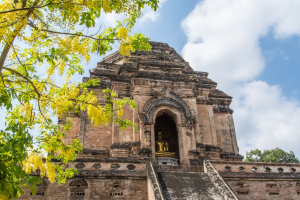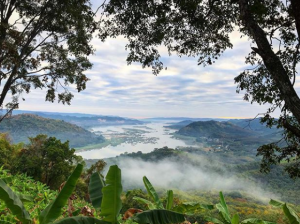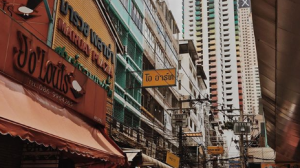Chiang Mai Green
Near to the infamous Golden Triangle the Rose of the North is blooming.
Chiang Mai is waving the green flag for those travellers searching for a healthy holiday. Mountain biking, horseback riding, and golf head the list of green activities.
Chiang Mai, known as The Rose of the North, overlaps culturally with the bordering countries of Myanmar and Laos. The area around Chiang Mai has preserved its indigenous heritage. Many of the hilltribes still live according to their ancient customs and methods of agriculture.
For those who want to venture a little further there is the infamous Golden Triangle and the national park of Doi Inthanon, Thailand’s highest mountain.

Chiang Mai’s serenity can be traced to its Buddhist temples. On a 5000-foot-high mountain, the 14th-century Wat Phra Thai Doi Suthep is one of the city’s holiest shrines. A twisting road of hairpin turns leads up the mountain to a spot near the summit where as legend as it-in the late 14th century an elephant entrusted with holy Buddhist relics stopped, trumpeted and lay down to mark the site of future sanctuary. From here on a clear day, here’s a striking view over the city. Colours abound. Groups of orange-robed monks, vendors selling incense, and lotus-bloom offerings and believers applying gold leaf to an already heavily entrusted Buddha.
Wat Sua Dok, built on the site of the road garden, has a 500-year-old Buddha and a complex of tombs containing the royal ashes of Chiang Mai’s former rulers. Wat Phrah Singh’s treasure is an early 19th-centry multi-tiered wooden building, decorated with intricate carvings. But the most impressive temple, for sheer size, is the huge Wat Chedi Luang, which dates from 1441. The 140-foot Wat was even bigger before a 16th century earthquake toppled more than 100 feet from its top.
The craftsmanship of the temple of construction can be discovered in Chiang Mai’s ateliers. Lanna House is the source of some of the best antique furniture, old and new silver, Burmese lacquer, ironwood carved elephants and tribal cloth from the mountain people of the Golden Triangle.

Looking out across the Mae Rim Valley from the enchanting pavilion of The Regent Resort Chiang Mai, it is not hard to imagine why King Mengrai chose this picturesque area for the capital of the former Lan-Na Thai Kingdom.
Chiang Mai is on the Ping River 700 kms north of the Bangkok. History speculates that King Mengrai chose this spot not just because of its natural advantages, but because the signs were auspicious. Shortly before he made his decision in 1296 on the site of his new capital, a gathering of rare animals had been seen there-two white sambar deer, two white barking sheep, and a white mouse with a family of five.
Today the resort has won the praise of Anusorn Khuhakarn, a well-known and highly respected mystic, yogi, healer, and Feng Shui professional based in Chiang Mai. Anusorn, who has a huge following throughout Eastern Asia, is impressed with the Feng Shui arrangement of the resort. According to the concept of Feng Shui, an ancient Chinese philosophy on which many people in Asia base their lives, the resort is in harmonious balance with nature’s energies.
The auspicious influences and healing elements include the gently undulating land, clean air, gentle breezes, and clean waterways meandering slowly through the resort’s lush green vegetation. It’s an idyllic, tranquil setting, making the resort an appealing getaway from the stresses and strains of modern city life.
The resort’s lay out symbolises the horse shoe or armchair concept with accommodations depicting the ancient Lanna style of architecture. Built on elevated ground looking out over the rice fields and landscape towards the mountains, the “green dragon” and “white tiger” are represented in this layout style, signifying an abundance of good fortune, wealth, comfort and health.
The History of Chiang Mai
Chiang Mai became the official Lan-Na-Thai capital in 1345. The 15th century was the golden age of Chiang Mai, when Lan-Na art and power reached its peak during the reign of King Tilokaraja.
He was a great warlord and a devout Buddhist, able in 1455 AD to arrange the eighth world Buddhist council in Chiang Mai. The fact that this was feasible attests to the power, wealth, safety and communications that Lan-Na enjoyed.
It was not to last long, though. Squabbling between pretenders to the throne by a succession of kings and princes weakened the nobility.
In 1545 AD Chiang Mai suffered a devastating earthquake, and in 1558 AD Chiang Mai was taken by the Burmese empire of Pegu.
Most of Lan-Na remained under Burmese control for over 200 years, although for much of the population the effects were barely noticeable except during the odd small-scale rebellion, when the Burmese would sack a rebellious dukedom as a punishment.

There was no direct colonization, but annual tributes to Pegu had to be paid, and a Burmese prince sat on the throne in Chiang Mai.
Once secure in Lan-Na, the Burmese nobility looked to extend their influence further, particularly towards the kingdom of Ayutthaya to the south. Finally, in 1767 AD, the Burmese King Syn Byu Shin took and sacked Ayuttaya, destroying most of the culture and heritage of this previously magnificent city.
Now secure in most of central Southeast Asia, the Burmese, together with an army recruited from Lan-Na, turned their attention eastwards, and mounted an attack on the empire of Luang Prabang (now Laos).
The war drained Lan-Na of wealth and population, and pushed the people too far, leading to a series of determined rebellions.
From the city of Tak, a general named Taksin achieved victories over the Burmese, and eventually became the first king of a new central Thai empire based at Thonburi (on the west bank of the Chao Phraya, opposite Bangkok).
Further north, the chief of Lampang, Kawila, mounted a rebellion which led to the retaking of Chiang Mai, and the end of Burmese domination, in 1774 AD.
Taksin become the first king of a united Thailand, and appointed Kawila as governor of Chiang Mai. The City was in a state of awful disrepair, in fact it was a ghost town until the beginning of the 19th century.
In 1781 AD Taksin was declared insane and executed. His successor, and former general, Phra Buddha Yod Fa, moved the capital of Thailand across the river from Thonburi to its presents position at Krung Thep (Bangkok) on the east bank, more easily defended from any more Burmese attacks from the west.

Phra Buddha established the Rama Dynasty who have ruled Thailand ever since (the present king, Bhumipol Adulyadej, is Rama IX). It was not until 1804 that the last toehold of the Burmese in Thailand, at Chiang Saen, was retaken.
In the 19th century, Lan-Na became an unnoticed backwater of Thailand. It was ruled by a series of ineffectual governors, and the population declined in number and vigour. In the mid 19th century, European powers began to view Lan-Na with interest.
The French established an Indo-Chinese empire in Vietnam, Cambodia, and Laos to the east, and the British controlled India and Burma to the west.
It was a delicate time, with both superpowers eyeing Lan-Na and each other. It was largely thanks to the statesmanship of King Mongkut and his son Chulalongkorn that Lan-Na preserved its independence.

Territory was ceded to France to the east of the Maekhong River, and logging concessions given to the British. Much was made by the kings of Thailand of the importance of the neutral buffer zone between French and British dominions.
There was a small skirmish with boats of the French navy over ownership of some tiny islands in the Maekhong River, and a rapid migration of Thais to the disputed area around Mae Hong Son which the British claimed because the population was more Burmese that Thai.
King Chulalongkorn, belatedly realizing how ineffectually Lan-Na had been governed, appointed a talented High Commission to administer the north, and encouraged missionaries who imported not only Christianity (which was largely rejected by the Thais) but modern education, health care and administration.
In the 1920’s, a British governor was appointed by the king as Governor of Lampang. The railway reached Chiang Mai in 1927, which together with a comprehensive road building programme, drew Lan-Na into the mainstream of Thai life and prosperity.
Places to stay
- Amari Rincome Hotel Comfortable family ad business hotel.
- Ban Klang Doi Garden Resort A selection of houses and rooms catering to families or couples.
- Belle Villa Located 30 minutes from Chinag Mai Int. Airport
- Buarawong Residence & Hotel Situated a few hundred metres from the Night Bazaar.
- Chiangmai Gate Hotel Rooms are decorated in traditional Lanna Thai style.
- Felix City Inn Five minutes from the airport and one kliometre from the Night Baazaar.
- Galare Thong Tower – luxury condomimium with apartments for rent to short-time guests.
- Imperial Mae Ping Hotel Superior First Class hotel located close to the Night Bazaar.
- Lanna Resort -Explore various services provided by this hotel and resort. Provides photographs of scenery surrounding the hotel, bedrooms and meeting room.
- Mae Rim Lagoon Hotel – Check out this hotel’s features, which include views of a nearby lake. Rates listed include breakfast.
- Palm Springs Hotel & City Resort Û Fully furnished rooms, restaurant, swimming-pool, tennis courts and gardens.
- Paradise Hotel & Guesthouse 210 Lanna style rooms, located near the shopping and entertainment district.
- Red Hibiscus Guesthouse – Located within the old city wall of Chiang Mai, this hotel presents photos and descriptions of the property and its surrounding area
- Royal Princess Situated close to the shopping and entertainment district.
- Suan Bua Hotel & Resort – Offers guests mediation therapy and views of nearby hills.
- Tarin Hotel -Preview this hotel through photos of the lobby, restaurant and pool. Includes some rates and a form for reservations.
Resources
- Wikipedia Chiang Mai
- Lonely Planet
- 25 Best Things to Do in Chiang Mai (The Crazy Tourist)
- Visit Chiang Mai






Add Comment